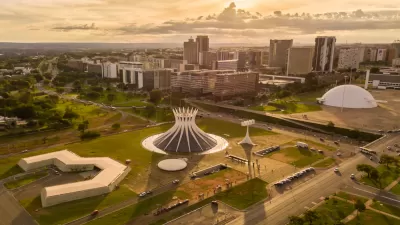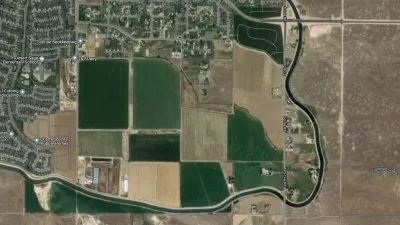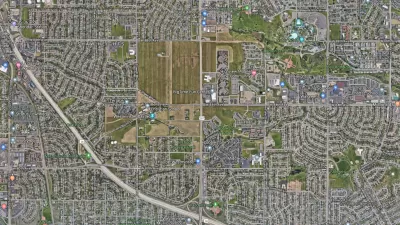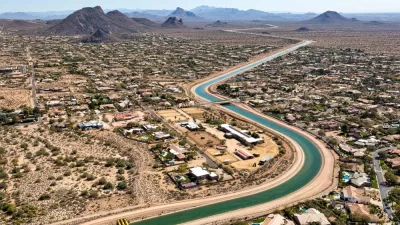A recent essay advocates for the development of a new city in California to alleviate the state's housing crisis. The argument needs a few tweaks.

Nathan J. Robinson, editor of Current Affairs magazine, recently published what appeared to be a draft of an essay in his own publication that discussed building brand-new, government-developed cities in the California's hinterlands. Some of his arguments don't make sense, though. It seems whoever was supposed to edit Robinson's piece hit "publish" prematurely.
I know California pretty well, so I took a crack at editing it, both for argumentation and factual veracity. California is complex, and its housing crisis is complex. It's important to approach both realistically.
Proposed deletions are in italics and additions are in bold. Original hyperlinks have been deleted, with new suggestions added.
-JS
There shouldn’t be a housing crisis in California. It’s not like California is full—the state’s land is vast and mostly sparsely populated but with scarce water supplies, complex regimes of land ownership, and great distances between major population and employment centers. Most Californians live in and around the state’s few many big urban centers: Los Angeles, San Francisco, San Diego, San Jose, Sacramento; their surrounding suburbs and satellite cities; and many medium-sized urban areas like Fresno, Bakersfield, and the Inland Empire. In these cities' varied jurisdictions, housing is insanely expensive....
Everyone Low- and moderate-income folks talk about the California housing crisis, but nobody seems to have any too many cash- and/or house-rich Californians have no interest in any idea how to fix it. Cities spend fortunes on homeless aid programs, without fixing the problem. There’s a development-friendly lobbying coalition grassroots movement of organizations and activists that calls itself the "YIMBY" movement, (which stands for “yes, in my backyard”) that argues for reducing regulations so that the free market can work its magic and many arbitrary and, often racist, impediments will be reduced and the political will of non-wealthy, non-homeowning citizens will be heard in the hopes of providing more housing. You’ll hear many urbanists say that the problem is insufficient density and zoning and wealthy, white, obstructionist minorities, as they complain about rightly criticize regulations that limit many neighborhoods to single-family homes...
Yes No, you could never turn San Francisco into Hong Kong; you don't need to fill it with skyscrapers containing little sleeping compartments, and in order for the rent might to come down a bit. But would it still be San Francisco if it was more dense? Of course it would. Between 1990 and 2020, San Francisco grew by just under 150,000 people, and it's fundamentally the same great city as it was in 1990. The YIMBYs often dismiss the complaints of those of us disingenuous attempts by poeple who claim to value history and neighborhood character, branding their opponents “NIMBYs” and enemies of who are more concerned with their own home values than with either history or progress.
But Something very obvious totally insane has been left out of the whole discussion about California housing: the state clearly just needs some more cities like it needs a hole in the head. San Francisco can’t expand—it’s on a peninsula—so increased density means radically altering incrementally expanding the housing stock of the city. Some say that instead, the suburbs of San Francisco are the places that need to become more dense. But The discussions always take for granted accept the reality that we can and must improve and make more equitable with the cities we have, especially those that are relatively low-density and historically exclusionary.
Why, though? When China needs new places to accommodate a population that has grown by over 100 million and that has experienced massive rural-to-urban migration in the past 20 years for people to live, they just build a new city and/or add on to the housing stock and transportation infrastructure of existing cities. Controlled by an autocratic government with little regard for human rights, they’ve built 600 of them since 1949.... In Britain, after World War II, new towns were built to relieve urban overcrowding.... Many were ugly, because everything built car culture in the ‘50s and ‘60s was ugly detracted from human-scale aesthetics -- and many of these suburbs relied on cars because of where they were located. But The idea was sound disturbingly segregationist and technocratic: Instead of saying “How do we increase the density of London?” planners said “Where can we build some new cities? put the poor poeple while applying the wartime mentality and industrial-scale machinations of the military to the destruction of a natural landscape?"....
The problem is that building a new city from scratch requires the construction of infrastructure, acquisition of land, consent of stakeholders, environmental clearances, and identification of water supplies--among other things--that it would be a massive undertaking regardless of whether it was directed by public or private entities certain level of central economic planning of the kind associated with Soviet Communism and thus ideologically, financially, politically, and logistically verboten....
What we need is for the state to take charge and build whole new cities compel existing cities to embrace more housing and to grow smartly. We don’t need to raze historic neighborhoods and put in skyscrapers. We need wholly new urban centers redevelopment of countless urban parcels, be they as large as former stadiums or as small as single-family homes. Skeptics of government power may view this as an impossible task often have ulterior motives, or tell some story about how a real city can only arise “organically” rather than “from above.” are genuinely concerned about state overreach...
The exciting delusional thing about building new cities from scratch is that it allows you to avoid the mistakes are made in the “organic” (i.e., market-built) city and make a whole different set of mistakes. Los Angeles is a planning disaster product of its time. It’s not walkable everywhere, the public transit is horrible vastly improved, and everyone spends half their life stuck in traffic. This is totally unnecessary due to under-development of housing in strategic locations. A new smartly redeveloped city can be full of green spaces, of moderate density, and with everywhere accessible by efficient, green public transit. And a new smartly redeveloped city suburb can avoid undo all some of the disastrous errors that gave us the ugly suburban wastelands that constitute so much of contemporary “development"....
There is something a bit utopian about the idea of new cities. They give the opportunity to create something totally different, something that embodies our conception of how things ought to be, which may depart substantially from how they are now and gives us a useful foil for coming back down to Earth and considering how to make the urban fabric better in places that are already functional, well loved, and heavily populated. Any such proposal forces us to ask questions like: “In what way does the ideal city Los Angeles differ from 21st century Los Angeles?” The answer will likely be that it differs in many ways, and so the very act of building a new city incrementally redeveloping the city requires the revolutionary rethinking of the status quo.
This, I think, partly explains why the idea is completely “off the table” even though it makes perfect sense. It should be that the idea of razing historic neighborhoods sounds ridiculous and cramming welcoming ever more people into the confines of San Francisco sounds ridiculous fair and exciting. Instead, for some well known reasons, it is the much more rational idea of building new denser cities that has slipped out of the realm of the conceivable inspires some people to have temper tantrums. But why? And for how long? Will there never be big new widespread redevelopment or elegant "urban acupuncture" in cities? Seen from the outside, it is the capitalist realist topographical reality framework that is absurd operative, because it forces us to overlook consider obvious subtle solutions to our problems to preserve overcome flaws in a market system that does not satisfy human needs the esoteric whims of armchair planners.

Manufactured Crisis: Losing the Nation’s Largest Source of Unsubsidized Affordable Housing
Manufactured housing communities have long been an affordable housing option for millions of people living in the U.S., but that affordability is disappearing rapidly. How did we get here?

Americans May Be Stuck — But Why?
Americans are moving a lot less than they once did, and that is a problem. While Yoni Applebaum, in his highly-publicized article Stuck, gets the reasons badly wrong, it's still important to ask: why are we moving so much less than before?

Using Old Oil and Gas Wells for Green Energy Storage
Penn State researchers have found that repurposing abandoned oil and gas wells for geothermal-assisted compressed-air energy storage can boost efficiency, reduce environmental risks, and support clean energy and job transitions.

Minneapolis Bans Rent-Setting Software
Four cities have enacted restrictions on algorithmic software that can inflate rent costs.

Oakland to Add 244 New EV Chargers
Oakland plans to launch its new charging network at eight locations by the end of 2025.

Jane Goodall Inspires with Message of Hope, Resilience, and Environmental Action
Speaking in Pasadena, Jane Goodall offered a hopeful and inspirational message, urging global compassion, environmental responsibility, and the power of individual action to shape a better future.
Urban Design for Planners 1: Software Tools
This six-course series explores essential urban design concepts using open source software and equips planners with the tools they need to participate fully in the urban design process.
Planning for Universal Design
Learn the tools for implementing Universal Design in planning regulations.
Heyer Gruel & Associates PA
City of Moreno Valley
Institute for Housing and Urban Development Studies (IHS)
City of Grandview
Harvard GSD Executive Education
Salt Lake City
NYU Wagner Graduate School of Public Service
City of Cambridge, Maryland






























